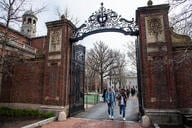You have /5 articles left.
Sign up for a free account or log in.
A new study from the Community College Research Center at Columbia University's Teachers College and the National Student Clearinghouse Research Center takes a state-by-state look at how students who take community college courses while still in high school fare after they transition to college.
The report finds that not only has the number of high school students taking these courses increased dramatically in the last decade, but these students are more likely to graduate high school, attend college and earn degrees than their peers. The study found that 88 percent of dual-enrollment students (who took community college courses in high school) continued in college after high school, and most achieved a degree or transferred within six years.
Nearly half of former dual-enrollment students first attended a community college immediately after high school, with 84 percent of those students re-enrolling at the college where they had taken the dual enrollment course.
"Any time I go to community colleges, they always assume that most of their dual-enrollment students are going directly to the four-year [institutions] after high school," said Davis Jenkins, a senior research scholar at CCRC and a co-author of the report. "But in fact, nationally, the majority are going on to the community colleges. This is a wake-up call to the community colleges … You have to recruit these students, and they should recruit them for bachelor's degrees with partnering institutions."
Community colleges have an opportunity to advertise themselves as low cost, high quality and close to home, he said, and places for formerly dual-enrolled students to earn an associate degree on their path to a four-year degree.
The report examined more than 200,000 high school students who took a community college class in 2010 and tracked them through 2016. It found a degree completion gap for lower-income students. In 13 states, the report found gaps of 10 percentage points or more in the completion rates between lower- and higher-income students who enrolled in a community college after high school.




